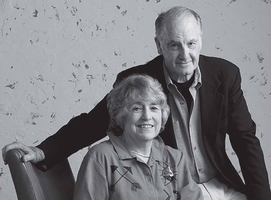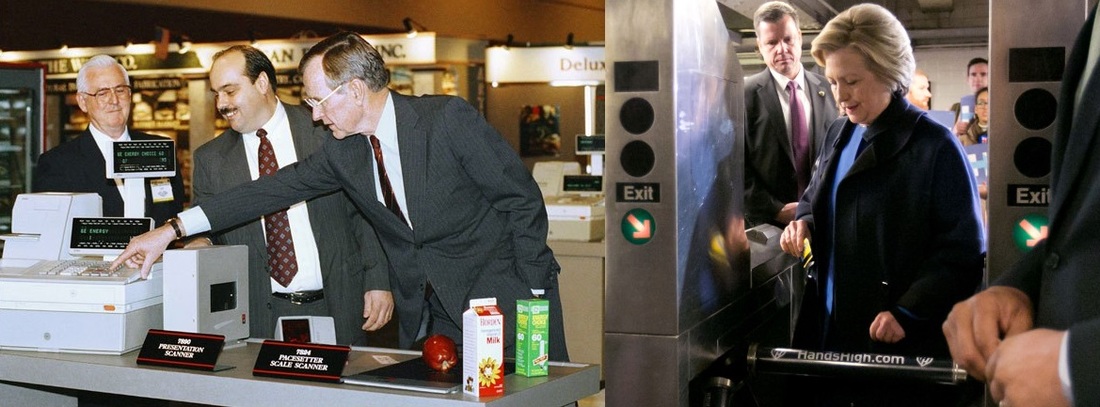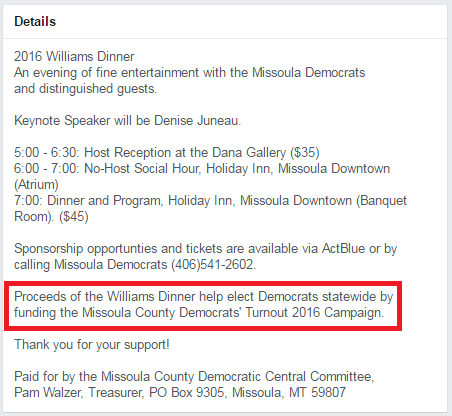 Pat and Carol Williams
Pat and Carol Williams
I say this because I make it quite clear that should Hillary become the nominee, I’ll be voting for Trump.
That said, wow – how about Bernie?!?
Currently he’s won 7 of the 8 primaries or caucuses. He’s doing so well, in fact, that he’s forcing Hillary out of her element.
We’ve seen how that turns out before:
Despite the problems of Hillary – kissing Wall Street’s ass, her non-excitement among young voters, the years of baggage – the Montana Democratic Party will fall all over itself to support her.
Hell, they’ve already sold the state’s 27 delegates to Hillary for a $64,100 donation to her victory fund.
This shouldn’t really surprise anyone. After all, we know full well that the Montana Democratic Party is seen as nothing more than a funnel, a funnel that can get money from local areas to national.
Nothing shows that more clearly than the annual Williams Dinner.
As you can see, this year it’s on April 30 and it’ll have Denise Juneau as the main speaker.
I’d like you to pay attention to where the money goes, however – to “help elect Democrats statewide by funding Missoula County Democrats’ Turnout 2016 Campaign.”
So…what’s the Missoula County Democrats’ Turnout 2016 Campaign?
I have no idea, nor was I able to find anything on that.
What I do know is that in the past, money from the Williams Dinner has been used to help national races, not local races.
I know this because I’ve seen the numbers.
I don’t have numbers for 2015 but you might remember my post-election report from November 2014 that mentioned the dinner.
Here’s what I wrote:
Again, local is waiting on state which is waiting on national. And when I say waiting on national, I mean we’re tapping on a turtle’s shell and hoping they stick their head out soon so we can get some direction.
This is the wrong approach, and the numbers tell the tale. From the Williams/Williams fundraising dinner in May, the Missoula Democrats raised $19,738.87. The cost of that was $11,668.35, leaving us with a net gain of $8,070.52. Next, or at least over the course of the year, $7,800 was given to campaigns. That leaves just $270.52 out of that Williams Dinner.
There are a few other expenditures here and there, some more income, but let’s face it, is the one major cash-cow for the Missoula Democrats. And we’re giving $7,800 to campaigns? Campaigns need to be giving that money to us!
Tickets to the Williams Dinner cost $45 or $80 if you want the reception as well.
Of course, you can pay a lot more…a lot more.
I’m sure they’ll do quite well, taking in around $8,000. Again, I’m sure about $300 of that will go to local races.
When I say local, I’m pretty much talking about the legislature, school board, maybe even City Council when that comes around.
I sure as shit ain’t talkin’ about Hillary or even Bernie. I’m not talking about Denise Juneau, either.
Yeah…she’s statewide – that’s not local.
Besides that, she should have no problem tapping into the corrupt donor network that the National Democrats rely on.
Hell, we’re funneling so much money up the chain that she should be given the phone and email list.
I’m not sure she is, however. Remember, it’s more important that any money Juneau could get instead gets funneled toward Hillary.
Not only does Hillary need to knock off that damn Bernie but she needs to win the general as well.
We’ve seen quite clearly that Jon Tester has no problem attacking Democrats he doesn’t like, why should others be different?
They’re not, something I know quite well firsthand.
For the most part I just feel sorry. I feel sorry for everyone that thinks this Williams Dinner is going to help them.
Who are the Williams’ anyways?
Montana's Pat Williams
He went to the University of Montana then William Jewell College is Missouri and then the University of Denver in Colorado. It was at that last one that he finally got a BA. After that he became a teacher in Butte.
In 1966 Pat Williams, as he then went by, was elected to the Montana House of Representatives out of Silver Bow County’s District 23. He won reelection in 1968 and then starting in 1969 he was the executive assistant to Representative John Melcher in Washington.
In 1974 Williams tried for the U.S. House of Representatives but was defeated by Max Baucus. Baucus nabbed 29,000 votes in the primary, Williams managed 21,000 and 1956 gubernatorial loser Arnold Olsen picked up 17,000.
Williams came back in 1978 to try for the 1st District U.S. House Seat and defeated Dorothy Bradley in the primary. Next up he defeated Jim Waltermire in the general, 86,000 votes to 64,000, or 57% to 43%.
The 1986 book Politics in America: The 100th Congress tells us that “Williams’ strong ties to organized labor ‘helped bring him to Congress and help keep him there,’” a key part of that being his “high AFL-CIO vote rating.”
In regard to labor, Williams “led efforts to ban private employers from using lie-detector tests and staunchly defended the sometimes controversial Occupational Safety and Health Administration.”
Williams began serving in Washington in 1979 and was also a key supporter of environmental legislation. He sought to protect the Wilderness Act of 1964 so that it’d cover National Forest lands as well. He advocated for higher taxes on corporations as well as reductions in defense spending so that the country could lower the deficit.
Politics in America described Williams as:
“A man who likes to open a debate with a table-pounding harangue complaining of injustice to unions or teachers, then turn around and negotiate patiently and amicably with those he has denounced as unjust.”
Williams was “part of the emerging liberal coalition on the key House Budget Committee” in 1986, though the committee was not strong enough “to change the Reagan administration trend toward reduced government action.”
Williams was instrumental in getting more rights for the disabled, especially in schools. He helped produced “a bill giving states more incentives to expand handicapped services to preschool children.”
The big problem came in 1992 when the first election of the joint-districts took place. Both Williams and Ron Marlenee had been in Washington since 1978. Only one of them would remain.
Politics in America described Marlenee as someone with “strong opinions, but he his not much when it comes to building coalitions to promote them.”
In 1985 Marlenee got into a “one-man crusade,” going after “a popular provision” of the Farm Bill that “aimed at cutting off crop subsidies for ‘sodbusters’ who risk soil erosion by converting marginalized grazing land to crop land.”
To Marlenee, this smacked of a “confiscation of property” and he labeled it as “the single greatest threat for bureaucratic abuse.”
“Marlenee ‘has rarely hesitated to show his frustration with the Department of Agriculture, regardless of which party is running it” and also has shown “deeply rooted resentment of the federal government” in his work on the Interior committee.”
For the most part, Marlenee “used his Interior post to protect cattlemen from increased grazing fees,” and not as a sounding board or platform to combat environmentalists as the “Republican forces on the panel” would have liked.
The two men duked it out that summer of ’92 and in the end Pat Williams, veteran of the western district, won out. The vote was 203,000 for Williams and 189,000 for Marlenee, or 52% to 48%.
Pat Williams would serve until 1997. He decided not to run again in the 1996 election, something that allowed the Republicans to pick it up.
Pat Williams currently lives in Missoula. He’s 78 years old.
He and his wife will have their annual dinner at the end of this month.
Perhaps it’s an attempt to stay relevant, perhaps a bid to help those national folks that Pat Williams still knows.
We know damn-well that the money they raise won’t do much for Missoula.
That’s about par for the course when it comes to Dems these days…and perhaps was during Williams’ time as well.



